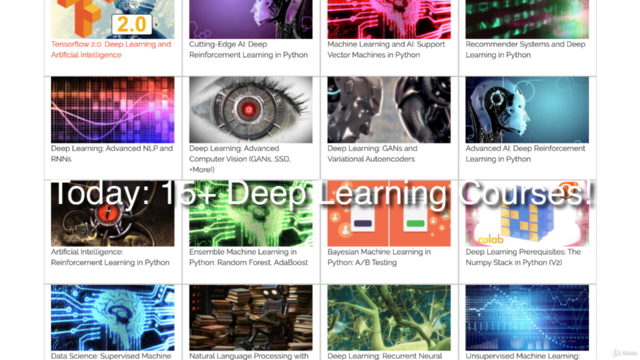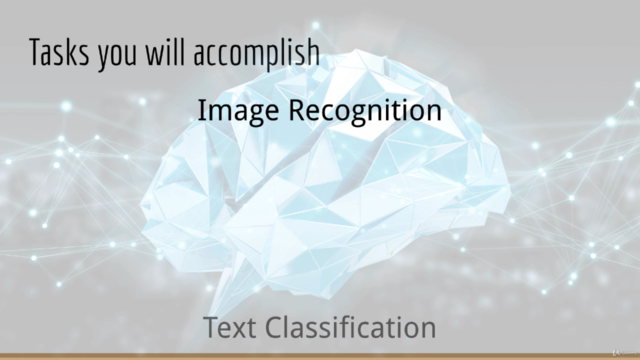Deep Learning: Convolutional Neural Networks in Python

Why take this course?
🎓 Deep Learning: Convolutional Neural Networks in Python 🚀
Course Headline:
Tensorflow 2 CNNs for Computer Vision & Natural Language Processing +More!
Unlock the Secrets of AI Pioneers! 🧠✨ Ever wondered how cutting-edge AI technologies like OpenAI ChatGPT, GPT-4, DALL-E, Midjourney, and Stable Diffusion really work? In this course, you will learn the foundations of these groundbreaking applications through one of the most potent Deep Learning architectures: Convolutional Neural Networks (CNNs).
Course Description:
Dive into the world of Deep Learning and explore the powerful capabilities of CNNs, which are pivotal in achieving state-of-the-art results in computer vision tasks like object detection, image segmentation, and generating photorealistic images. This course will provide you with a comprehensive understanding of convolution and its significance in deep learning, including its application in Natural Language Processing (NLP).
What You'll Learn:
- 🤖 The basics of machine learning and neurons to refresh your knowledge.
- 🧮 Neural networks for classification and regression, a brief refresher.
- 📊 Modeling image and text data in code.
- 🎨 Building an CNN using Tensorflow 2.
- 🔄 Techniques like batch normalization and dropout regularization in Tensorflow 2.
- 🌟 Image classification in Tensorflow 2.
- 📝 Data preprocessing for custom image datasets.
- ✍️ Using Embeddings in Tensorflow 2 for NLP tasks like spam detection, sentiment analysis, parts-of-speech tagging, and named entity recognition.
- 🧠 Hands-on experience in building a Text Classification CNN for NLP.
Course Materials: All materials are downloadable and installable for FREE! We will primarily use Numpy, Matplotlib, and Tensorflow to work through the course.
This course is designed to help you "see for yourself" via experimentation, focusing on understanding and building models rather than just using them. You'll learn how to visualize what's happening internally in your model, which is crucial for a deep understanding of AI concepts.
Suggested Prerequisites:
To get the most out of this course, you should have a grasp of:
- Matrix addition and multiplication.
- Basic probability (conditional and joint distributions).
- Python coding essentials: if/else, loops, lists, dicts, sets.
- Numpy coding: matrix and vector operations, CSV file loading.
Order of Learning:
For an optimal learning experience, we recommend following the Machine Learning and AI Prerequisite Roadmap available in the FAQ of our courses, including the free Numpy course.
Unique Features:
- 🔍 Every line of code explained in detail. Disagree? Email me, and I'll clarify!
- ✍️ No wasted time on unnecessary coding exercises. We value your time and focus on quality education.
- 📚 Not shy away from complex math. We delve into the algorithms that other courses might overlook.
Join us on this exciting journey into the depths of Deep Learning with CNNs and emerge equipped to build powerful models for computer vision and NLP. Let's embark on this adventure together! 🚀🧬
Enroll now and unlock the potential of AI with Convolutional Neural Networks in Python using Tensorflow 2! 🎉👩💻👨💻
Course Gallery




Loading charts...
Comidoc Review
Our Verdict
Deep Learning: Convolutional Neural Networks in Python, with its comprehensive approach to computer vision and natural language processing using CNNs, proves to be an excellent resource for those pursuing a deep understanding of the field. Despite minor shortcomings related to pacing and hyperparameter optimization, the course offers immense value through its in-depth explanations and real-world practical applications. Ideally suited for those with some exposure to computer science or data science concepts.
What We Liked
- Covers a wide range of topics from image recognition to natural language processing with CNNs
- Thorough explanations of mathematical concepts underpinning neural networks and deep learning
- Hands-on coding exercises at every step, enabling better retention and understanding
- Excellent coverage of real-world datasets providing valuable practical experience
Potential Drawbacks
- Some students might find the initial pace challenging; it caters more towards those with some prior knowledge in computer science or data science domains
- Pacing can be inconsistent, occasionally creating a need for external resources to fill gaps
- Limited in-depth exploration of hyperparameter selection and network optimization techniques
- Feedback suggests some instances of unresolved queries regarding course materials